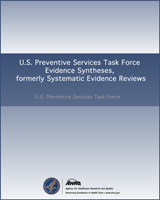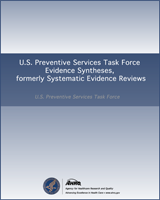NCBI Bookshelf. A service of the National Library of Medicine, National Institutes of Health.
This publication is provided for historical reference only and the information may be out of date.
Structured Abstract
Purpose:
To evaluate the evidence on screening and treating asymptomatic adults for carotid artery stenosis (CAS) for the U.S. Preventive Services Task Force (USPSTF).
Data Sources:
PubMed/MEDLINE, the Cochrane Library, EMBASE, and trial registries through September 2013; reference lists of published literature; MEDLINE searches for trials were updated through March 2014.
Study Selection:
Two investigators independently selected studies reporting on asymptomatic adults with CAS, including randomized, controlled trials (RCTs) of screening for CAS; RCTs of carotid endarterectomy (CEA) or carotid angioplasty and stenting (CAAS) versus medical treatment; RCTs of medications versus placebo added to current standard medical therapy; multi-institution trials or cohort studies reporting harms; relevant systematic reviews; and studies that attempted to externally validate risk stratification tools.
Data Extraction:
One reviewer extracted data and a second checked accuracy. Two independent reviewers assigned quality ratings using predefined criteria.
Data Synthesis:
No RCTs compared screening with no screening, CAAS with medical treatment, or assessed intensification of medical therapy. Given the specificity of ultrasound (range 88% to 94% for CAS ≥50% to ≥70%), its use in low-prevalence populations would yield many false-positive results. Only one fair-quality study attempted external validation of a risk stratification tool to distinguish persons who are more likely to have CAS; the tool's discrimination was inadequate (c-statistic for ≥50% CAS, 0.60; 95% CI, 0.56 to 0.64). Our meta-analyses of RCTs comparing CEA with medical therapy found an absolute risk reduction of 5.5 percent (95% CI, 3.9 to 7.0) for any nonperioperative stroke over approximately 5 years. Meta-analyses for perioperative (30-day) stroke or death after CEA found rates of 2.4 percent (95% CI, 1.7 to 3.1) using all trials of CEA, regardless of the comparator; and 3.3 percent (95% CI, 2.7 to 3.9) using cohort studies (7 studies; n=17,474). Rates of perioperative stoke or death after CAAS were similar or slightly higher. Other important potential harms of CEA or CAAS include nonfatal perioperative myocardial infarction (approximately 0.8% rate after CEA), cranial nerve injury, pulmonary embolism, pneumonia, local hematoma requiring surgery, and psychological harms (e.g., anxiety or labeling). Externally validated, reliable risk stratification tools that can distinguish persons with asymptomatic CAS who have increased or decreased risk for ipsilateral stroke or harms after CEA or CAAS are not available.
Limitations:
Medical therapy in trials varied and often lacked treatments that are now standard. For this reason, and because advances in medical therapy have reduced the rate of stroke in persons with asymptomatic CAS in recent decades, the true reduction of stroke or composite reduction of cardiovascular events is unknown. Trials utilized highly selected surgeons. No trials focused on a population identified by screening in primary care. Harms may be underreported.
Conclusion:
Current evidence does not sufficiently establish incremental overall benefit of CEA, CAAS, or intensification of medical therapy beyond current standard medical therapy. Potential for overall benefit is limited by low prevalence in the general asymptomatic population and by harms from screening and treatment. Evidence is insufficient to allow reliable risk stratification.
Contents
Acknowledgments: The authors gratefully acknowledge the following individuals for their contributions to this project and deeply appreciate their considerable support, commitment, and contributions: Tracy Wolff, MD, MPH, AHRQ Medical Officer; Kirsten Bibbins-Domingo, PhD, MD, Jessica Herzstein, MD, MPH, and Michael LeFevre, MD, MSPH, U.S. Preventive Services Task Force leads; Evelyn Whitlock, MD, MPH, Kaiser Permanente Research Affiliates EPC director; Tracy Beil, MS, Kaiser Permanente Research Affiliates EPC; RTI International–University of North Carolina EPC staff: Carol Woodell, BSPH, project manager; Meera Viswanathan, PhD, EPC director; Christiane Voisin, MSLS, librarian; Laura Small, BA, editor; and Loraine Monroe, publications specialist.
Prepared for: Agency for Healthcare Research and Quality, U.S. Department of Health and Human Services1, Contract No. HHSA-290-2012-00015-I, Task Order No. 2. Prepared by: RTI International–University of North Carolina Evidence-based Practice Center, Research Triangle Park, NC
Suggested citation:
Jonas DE, Feltner C, Amick HR, Sheridan S, Zheng ZJ, Watford DJ, et al. Screening for Asymptomatic Carotid Artery Stenosis: A Systematic Review and Meta-Analysis for the U.S. Preventive Services Task Force. Evidence Synthesis No. 111. AHRQ Publication No. 13-05178-EF-1. Rockville, MD: Agency for Healthcare Research and Quality; 2014.
This report is based on research conducted by the RTI International–University of North Carolina Evidence-based Practice Center (EPC) under contract to the Agency for Healthcare Research and Quality (AHRQ), Rockville, MD (Contract No. HHSA-290-2012-00015-I, Task Order No. 2). The findings and conclusions in this document are those of the authors, who are responsible for its contents; the findings and conclusions do not necessarily represent the views of AHRQ. Therefore, no statement in this report should be construed as an official position of AHRQ or of the U.S. Department of Health and Human Services.
The information in this report is intended to help health care decisionmakers—patients and clinicians, health system leaders, and policymakers, among others—make well-informed decisions and thereby improve the quality of health care services. This report is not intended to be a substitute for the application of clinical judgment.
This report may be used, in whole or in part, as the basis for development of clinical practice guidelines and other quality enhancement tools, or as a basis for reimbursement and coverage policies. AHRQ or U.S. Department of Health and Human Services endorsement of such derivative products may not be stated or implied.
None of the investigators has any affiliations or financial involvement that conflicts with the material presented in this report.
- 1
540 Gaither Road, Rockville, MD 20850; www
.ahrq.gov
- Review Screening for asymptomatic carotid artery stenosis: a systematic review and meta-analysis for the U.S. Preventive Services Task Force.[Ann Intern Med. 2014]Review Screening for asymptomatic carotid artery stenosis: a systematic review and meta-analysis for the U.S. Preventive Services Task Force.Jonas DE, Feltner C, Amick HR, Sheridan S, Zheng ZJ, Watford DJ, Carter JL, Rowe CJ, Harris R. Ann Intern Med. 2014 Sep 2; 161(5):336-46.
- Review Screening for Asymptomatic Carotid Artery Stenosis in the General Population: An Evidence Update for the U.S. Preventive Services Task Force[ 2021]Review Screening for Asymptomatic Carotid Artery Stenosis in the General Population: An Evidence Update for the U.S. Preventive Services Task ForceGuirguis-Blake JM, Webber EM, Coppola EL. 2021 Feb
- Review Screening for Chronic Obstructive Pulmonary Disease: A Systematic Evidence Review for the U.S. Preventive Services Task Force[ 2016]Review Screening for Chronic Obstructive Pulmonary Disease: A Systematic Evidence Review for the U.S. Preventive Services Task ForceGuirguis-Blake JM, Senger CA, Webber EM, Mularski R, Whitlock EP. 2016 Apr
- Review Lipid Screening in Childhood and Adolescence for Detection of Familial Hypercholesterolemia: A Systematic Evidence Review for the U.S. Preventive Services Task Force[ 2016]Review Lipid Screening in Childhood and Adolescence for Detection of Familial Hypercholesterolemia: A Systematic Evidence Review for the U.S. Preventive Services Task ForceLozano P, Henrikson NB, Dunn J, Morrison CC, Nguyen M, Blasi PR, Anderson ML, Whitlock E. 2016 Aug
- Review Screening For Asymptomatic Carotid Artery Stenosis[ 2007]Review Screening For Asymptomatic Carotid Artery StenosisWolff T, Guirguis-Blake J, Miller T, Gillespie M, Harris R. 2007 Dec
- Screening for Asymptomatic Carotid Artery StenosisScreening for Asymptomatic Carotid Artery Stenosis
- ribosomal protein L32, partial (chloroplast) [Solanum betaceum]ribosomal protein L32, partial (chloroplast) [Solanum betaceum]gi|1047816520|gb|ANW48567.1|Protein
- Aichryson bollei voucher MA herbarium 28/2019 (71FP19) ribulose 1,5-bisphosphate...Aichryson bollei voucher MA herbarium 28/2019 (71FP19) ribulose 1,5-bisphosphate carboxylase/oxygenase large subunit (rbcL) gene, partial cds; chloroplastgi|2020258904|gb|MW818139.1|Nucleotide
- Ipomoea huayllae voucher F-12939 small subunit ribosomal RNA gene, partial seque...Ipomoea huayllae voucher F-12939 small subunit ribosomal RNA gene, partial sequence; internal transcribed spacer 1, 5.8S ribosomal RNA gene, and internal transcribed spacer 2, complete sequence; and large subunit ribosomal RNA gene, partial sequencegi|1783629282|gb|MN825322.1|Nucleotide
- Selaginella mazaruniensis voucher N. Y. Sandwith 1248 (U) from Guyana ribulose-1...Selaginella mazaruniensis voucher N. Y. Sandwith 1248 (U) from Guyana ribulose-1,5-bisphosphate carboxylase/oxygenase large subunit (rbcL) gene, partial cds; chloroplastgi|1142914630|gb|KY023078.1|Nucleotide
Your browsing activity is empty.
Activity recording is turned off.
See more...

